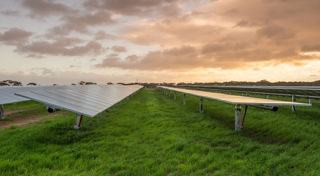CEFC congratulates IPWEA on new resource making it easier to switch to efficient LED street lighting
20 May, 2019
Local governments, main road agencies and utility staff looking to put forward a robust case for upgrading to LED street lighting now have a handy new resource.
The Institute of Public Works Engineering Australia’s (IPWEA) Model Business Case for Street Lighting and Smart Controls Upgrades is available through the Street Lighting and Smart Controls (SLSC) website
Written with support from the Clean Energy Finance Corporation (CEFC) and the Australian Government’s Department of the Environment and Energy, the Model Business Case provides guidance for those wanting to put forward a compelling and accurate case for making the change to LED street lighting and smart controls.
CEFC CEO Ian Learmonth congratulated IPWEA on the Model Business Case which is a template document that can be adapted for both large and small street lighting projects in urban and rural locations.
“Street lighting is a major contributor to the carbon emissions of local councils, but LED lighting and smart controls can go a significant way towards reducing that impact, by substantially reducing energy use,” Mr Learmonth said.
“We’ve previously worked with councils who have made the switch to LED street lights and have achieved energy savings of around 70 per cent. We’re very supportive of others wanting to follow suit and think this resource will help overcome a major identified hurdle by making it easier to clearly present the business case for change.”
IPWEA estimates that almost 1 million old lights in Australia are likely to be replaced in the next three to four years, in large part to retire old mercury vapour lights that can still be found on Australian roads.
IPWEA Acting CEO Ben Balov said: “IPWEA modelling shows that if every street light in Australia were converted to LEDs, councils would slash $100 million off their annual street lighting bills and reduce our street lighting’s energy use and greenhouse gas emissions by at least 52 per cent. When you add in smart controls that allow street lights to be dimmed when appropriate, that energy reduction can be as high as 72 per cent.
“Sitting down to create a business case for a relatively new and complex field can understandably be daunting. We want to remove as many barriers as possible for best-practice LED and smart control changeovers,” Mr Balov said.
The Model Business Case contains instructions and prompts to guide the writer through the process. It is written in plain English and is available under a Creative Commons licence, making it widely and freely available.
ABOUT THE SLSC PROGRAM
The IPWEA SLSC Program was launched in 2016 to accelerate the efficient adoption of modern street lighting and smart controls technologies and best practices throughout Australia and New Zealand, in support of the government's Energy Productivity and Smart Cities agenda.
ABOUT IPWEA
IPWEA is the peak not-for-profit association for public works and engineering professionals across Australia and New Zealand. It provides training, publications and advocacy to support its 4000-plus members and 20,000 community of engineering professionals who provide essential community infrastructure. Visit www.ipwea.org.
Media release, 2019




